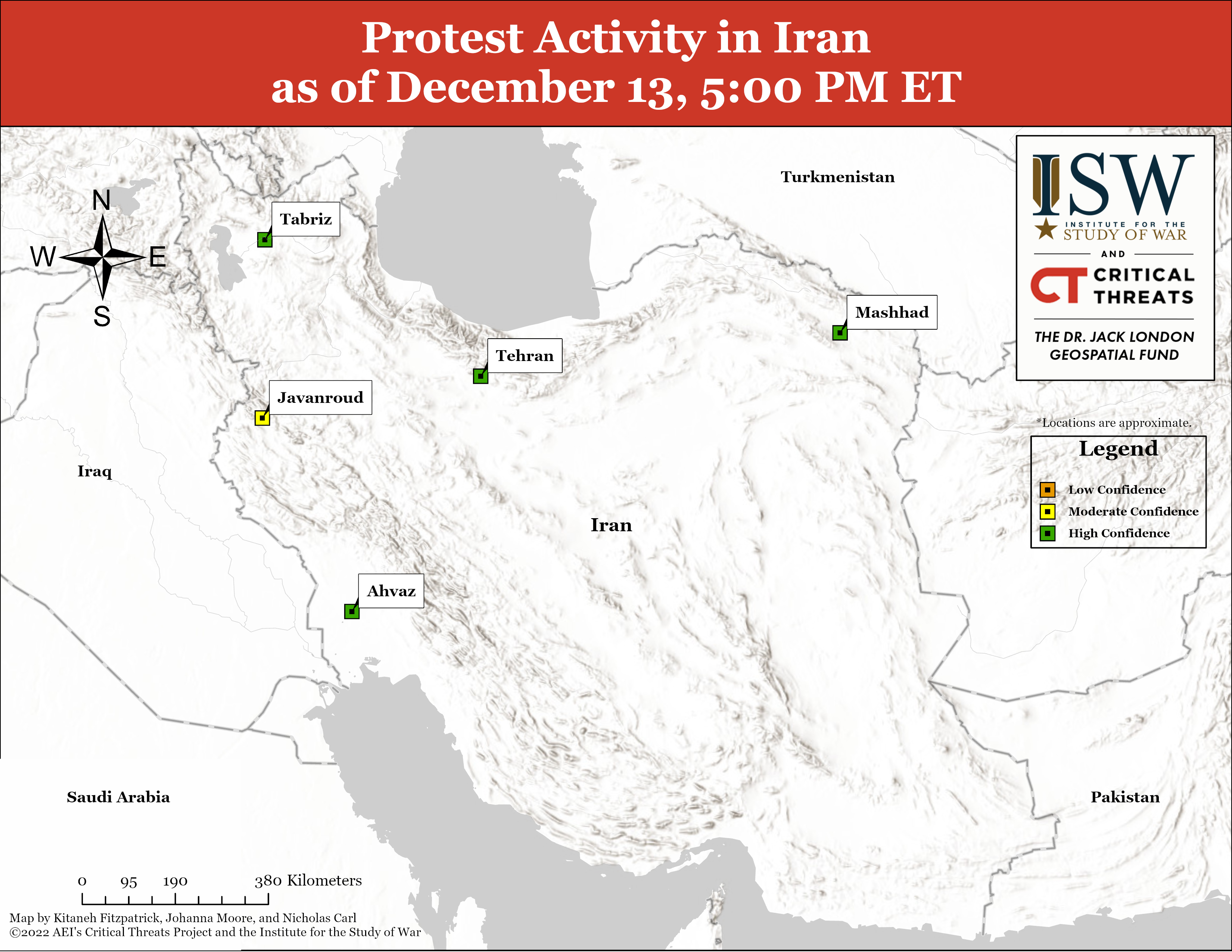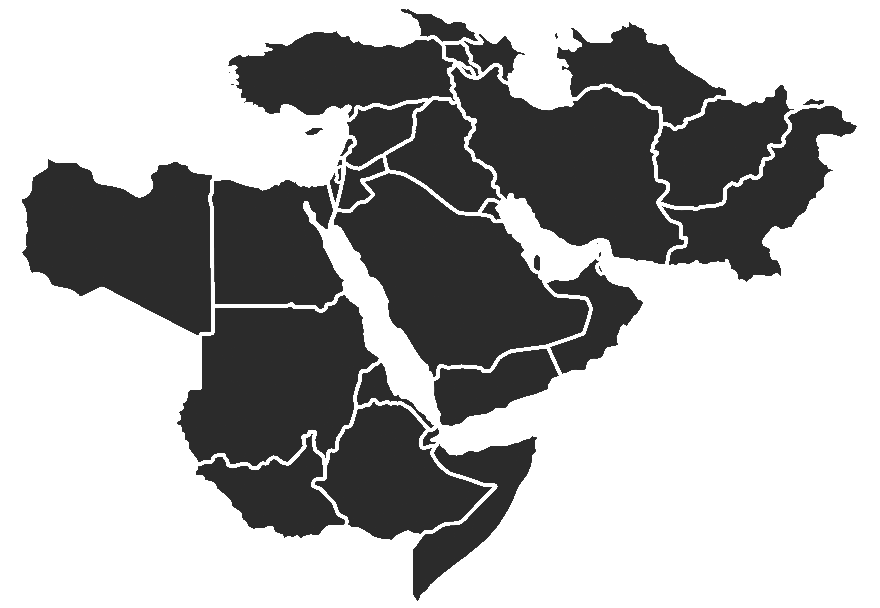{{currentView.title}}
December 13, 2022
Iran Crisis Update, December 13
December 13, 5:00 pm ET
The Iran Crisis Updates are produced by the Critical Threats Project (CTP) at the American Enterprise Institute with support from the Institute for the Study of War (ISW). To receive Iran Crisis Updates via email, please subscribe here.
The Iranian regime has replaced key clerics responsible for indoctrinating a significant portion of the security forces, possibly to improve efforts to ideologically control security officers. Senior Iranian cleric Abdollah Hajji Sadeghi appointed three new clerics to key leadership posts in the Basij Organization on December 13.[1] Hajji Sadeghi is responsible for representing Supreme Leader Ali Khamenei to the Islamic Revolutionary Guards Corps (IRGC). He appointed:
- Ali Rezaei as supreme leader representative to the Basij Organization;
- Karim Sararfaraz as supreme leader deputy representative to the Basij Organization; and
- Mahmoud Mohammadi Shahroudi as Basij Professors, Students, and Clerics Organization chief.
Khamenei maintains a network of clerical representatives, such as Hajji Sadeghi, who oversee every echelon of the state security services and act as political commissars.[2] They control the security services’ ideological-political training (i.e., indoctrination), the dissemination of propaganda, the spiritual commitment of security personnel, and seek to ensure the services’ subordination to the will of the supreme leader.
It is unclear why Hajji Sadeghi ordered these changes now, although they may be related to the protest crackdown. He may have sought to install new figures to reinforce the ideological commitment of Basij security officers. The Islamic Republic has experienced small-scale defections and insubordinations among security personnel during protest crackdowns throughout its history, and Iranian authorities likely seek to mitigate that risk.[3] The new supreme leader representative to the Basij Organization, Ali Rezaei, is particularly well-positioned to oversee these efforts in the Basij given his experience. Rezaei managed ideological education and training in the Basij before his promotion.[4]
It is noteworthy that Hajji Sadeghi passed over Mahmoud Mohammadi Shahroudi for both the roles of supreme leader representative and deputy representative to the Basij. Shahroudi was the supreme leader deputy representative to the Basij before the latest appointments and would therefore have been a logical candidate to become the new overall supreme leader representative to the Basij. Hajji Sadeghi instead appointed Shahroudi to head the Basij Professors, Students, and Clerics Organization, which Hajji Sadeghi may have meant as a demotion. Hajji Sadegh’s decision to clean house likely reflects his desire to significantly change the regime approach to indoctrinating and monitoring Basij personnel.
Ensuring the ideological subordination and loyalty of Basij personnel is essential to sustaining the regime protest crackdown. The Basij operates quasi-professional paramilitary units that the regime uses to violently suppress dissent and support the Law Enforcement Command (LEC) against protests.[5] These units receive varying levels of ideological-political training and instruction in civil defense, counterinsurgency, and security operations. Losing the loyalty of these security personnel would deprive the regime of a key instrument in its repressive toolkit and possibly strengthen the protest movement if any significant number of those officers provide demonstrators their expertise and support.
The broad mission set of the Basij Organization may complicate regime efforts to find effective commanders and managers for it. The Basij penetrates every segment of Iranian society, with duties that include organizing and recruiting regime supporters, indoctrinating its members, producing state propaganda, conducting moral policing, and suppressing political opposition in addition to its role within the security forces.[6]
Protest coordinators and organizations have planned more anti-regime demonstrations in the coming days. Social media account 1500 Tasvir stated that protesters will commemorate the execution of Mohsen Shekari in Tehran on December 14.[7] The Karaj Neighborhood Youth called for protests on December 15 to commemorate the 40th day since the regime killed protester Mehdi Hazrati.[8] The United Neighborhood Youth called for countrywide protests on December 20-21 in response to the execution of arrested protesters.[9]
Key Takeaways
- The Iranian regime appointed key clerics responsible for indoctrinating a significant portion of the security forces, possibly to improve efforts to ideologically subordinate security officers.
- Protest coordinators and organizations have planned more anti-regime demonstrations in the coming days.
- At least eight protests occurred in five cities across five provinces on December 13.
- Tehran Prosecutor General Ali Alghasi Mehr announced that 400 detained protesters were assigned prison sentences.
- The LEC Intelligence Organization announced the arrest of an unspecified number of actors for targeting trucks.
- The Parliamentary Judiciary and Legal Committee approved three articles of a bill that would establish a police force for children and adolescents.
Anti-Regime Protests
At least eight protests occurred in five cities across five provinces on December 13. CTP assesses with moderate to high confidence that protests occurred in the following locations:
Tabriz, East Azerbaijan Province[10]
- Size: Medium
- Demographic: Tabriz University of Medical Sciences students
- Protester Activity: Silent march, threw nooses into a pile and colored the pile with red dye
- Note: Protesting execution of Mohsen Shakari and Majid Reza Rahnavard
Javanroud, Kermanshah Province[11]
- Size: Medium
- Note: Occurred in the early morning of December 13, protesting arrest of local teacher and cleric
Mashhad, Khorasan Razavi Province[12]
- Size: Small
- Demographic: Mourners
- Protester Activity: Gathered for funeral service at local mosque
- Regime Repression: Locked the doors to local mosque
- Note: Mourning the execution of Majid Reza Rahnavard
Ahvaz, Khuzestan Province[13]
- Size: Small
- Demographic: Highschool students
Tehran City, Tehran Province[14]
- Size: Small
- Demographic: Soore University students
CTP assesses with low confidence that protests occurred in the following locations:
Mashhad, Khorasan Razavi Province[15]
- Size: Undetermined
- Demographic: Al-Zahra University of Mashhad students
Tehran City, Tehran Province[16]
- Size: Small
- Area: Chitgar
Tehran City, Tehran Province[17]
- Size: Small
- Area: Ekbatan

Tehran Prosecutor General Ali Alghasi Mehr announced that 400 detained protesters were assigned prison sentences. Alghasi Mehr stated that the Tehran judicial branch sentenced 160 protesters to five-to-ten-year prison sentences; 80 protesters to two-to-five-year prison sentences; and 160 to up to two-year prison sentences. Alghasi Mehr added that the judiciary had fined 70 protesters charged with minor offenses.[18] The regime has thus far executed two protesters for participating in anti-regime protests.[19] Anti-regime protest documentation social media user 1500Tasvir warned its followers that the number of arrested protesters and protesters sentenced to death was so high that “we still cannot even cover one percent of them” on December 13.[20]
The LEC Intelligence Organization announced the arrest of an unspecified number of actors for targeting trucks. The announcement claimed that it identified over 87 instances of individuals throwing stones at trucks and 20 incidents of shooting at trucks. It is unclear where these incidents occurred.[21] Anti-regime demonstration groups called on protesters to target commercial actors who failed to participate in strikes scheduled from December 5-7, as CTP previously reported.[22]
The Parliamentary Judiciary and Legal Committee approved three articles of a bill that would establish a police force for children and adolescents. The police force would exist under Iran’s law enforcement command within the interior ministry.[23] Some human rights organizations estimate that security personnel have killed at least 68 children in their protest crackdown since anti-regime demonstrations began on September 16.[24] The establishment of a police force dedicated to children and adolescents will likely take several months to create and may suggest that the regime views protests among Iranian youth as a long-term threat.
Social media accounts reported that protesters set fire to a telecommunications facility in Mashhad, Khorasan Razavi Province.[25]
Axis of Resistance and Regional Developments
There was nothing significant to report today.
[1] https://www.hawzahnews dot com/news/1058835
[2] https://www.washingtoninstitute.org/policy-analysis/supreme-leader-and-guard-civil-military-relations-and-regime-survival-iran
[3] https://www.criticalthreats.org/wp-content/uploads/2021/12/Whatever-it-takes-to-end-it.pdf
[4] http://www.irna dot ir/news/84821211
[5] https://www.criticalthreats.org/wp-content/uploads/2021/12/Whatever-it-takes-to-end-it.pdf
[6] https://www.criticalthreats.org/wp-content/uploads/2021/12/Whatever-it-takes-to-end-it.pdf
[7] https://twitter.com/1500tasvir/status/1602587891758239745
[8] https://twitter.com/javanane_k/status/1602392664762040320?s=20&t=bbznMwhyAdAKYuqhhNgG8g
[9] www.listed dot to/@UYI
[10] https://twitter.com/iranworkers/status/1602679044297957378 ; https://twitter.com/RadioFarda_/status/1602673452346916864
[11]https://twitter.com/KurdistanHRN/status/1602441471214473217?s=20&t=6HG6OD3dKAiXiTzTCPXqnw ; https://twitter.com/Kolbarnews/status/1602426978233192451?s=20&t=Iuf2KRN8KMrmO0Nrv0UBXg
[12] https://twitter.com/1500tasvir/status/1602594314919579649 ;
https://twitter.com/iranworkers/status/1602566290228580352 ;
https://twitter.com/iranworkers/status/1602601353926279169 ;
https://twitter.com/iranworkers/status/1602653563087364101 ;
[13] https://twitter.com/iranworkers/status/1602708115945914369 ; https://twitter.com/Vahid/status/1602699756710543363?s=20&t=6HG6OD3dKAiXiTzTCPXqnw ; https://twitter.com/RadioFarda_/status/1602727891552313345?s=20&t=6HG6OD3dKAiXiTzTCPXqnw
[14] https://twitter.com/iranworkers/status/1602652216678031361
https://twitter.com/RadioFarda_/status/1602664998676975618
[15] https://twitter.com/iranworkers/status/1602652502218133504
[16] https://twitter.com/iranworkers/status/1602772417918681088?s=20&t=Aaw9g0WGr85SeNvTnfWjsg
[17]https://twitter.com/FattahiFarzad/status/1602764274392145920?s=20&t=Ot34n0geoDCv3GiKXEchuw
[18] http://mehrnews dot com/xZ4VP
[19] https://twitter.com/1500tasvir/status/1600885220521410562?s=20&t=DoBWpHbidI6NgVTMQ3_DEA ; https://www.amnesty.org/en/latest/news/2022/12/iran-public-execution-of-majidreza-rahnavard-exposes-authorities-revenge-killings/
[20] https://twitter.com/1500tasvir/status/1602686020696383490?s=20&t=bbznMwhyAdAKYuqhhNgG8g
[21] https://www.ilna dot ir/fa/tiny/news-1308589
[22] https://www.criticalthreats.org/analysis/iran-crisis-update-december-5#_edn66dc09c85a073d57567c2f744826a6db6e47a6d17ba76155892763d455e78356111
[23] https://www.irna dot ir/news/84969442/%D9%BE%D9%84%DB%8C%D8%B3-%D9%88%DB%8C%DA%98%D9%87-%D8%A7%D8%B7%D9%81%D8%A7%D9%84-%D9%88-%D9%86%D9%88%D8%AC%D9%88%D8%A7%D9%86%D8%A7%D9%86-%D8%AA%D8%B4%DA%A9%DB%8C%D9%84-%D9%85%DB%8C-%D8%B4%D9%88%D8%AF
[24] https://twitter.com/HRANA_English/status/1602439454131720196?s=20&t=lb61wP81450ZRrkwQvcI9Q
[25] https://twitter.com/iranworkers/status/1602682403847344129
